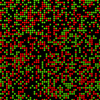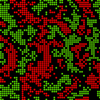Remote Ready Biology Learning Activities has 50 remote-ready activities, which work for either your classroom or remote teaching.
Serendip is an independent site partnering with faculty at multiple colleges and universities around the world. Happy exploring!

| Thinking About Segregation and Integration | 
|
| Introduction | The Basic Model | Exploration Tips | An Advanced Model | References |